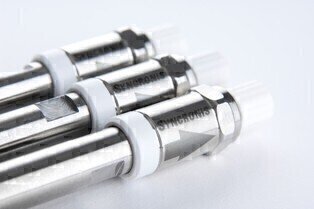HPLC, UHPLC
How to Avoid HPLC Column Overload
Sep 01 2014
In High Performance Liquid Chromatography (HPLC), the term overload describes a column condition where a large sample size impairs the performance of the column. Column overload happens when too much sample or solute is injected onto the column. Column overload reduces the performance of the column by causing retention time and peak shape problems.
Why do columns overload?
A column gets overloaded because there are more solute molecules seeking active sites than there are available sites in the column. In other words, there are a finite number of active sites on the stationary phase of a column available for the solute molecules to transiently bind to. As the sample moves through the column, each solute in the sample will bind to the stationary phase at an appropriate place — as determined by the chromatography conditions. It is this differential binding that allows the stationary phase to separate the sample into its components.
If all the active sites in the column are taken, then the solute will continue down the column in the mobile phase looking for more active sites. This causes the sample to be spread across a wider area in the column. This can lead to asymmetric peaks and changed retention times.
Of more significance is if overload leads to peak broadening, when small satellite peaks can be subsumed into larger peaks and become undetectable.
Types of overload
There are two main forms of column overload:
- Mass overload
- Volume overload
The consequences of each of these overload conditions are quite different.
Mass overload
Mass (sometimes termed concentration) overload occurs when too much analyte is injected onto the column. This causes the concentration of the solute in the stationary phase to move away from the idealized behaviour represented by the distribution constant. The distribution constant (KC) is the ratio of the concentration of the solute in the stationary phase (CS) to the concentration in the mobile phase (CM). Mass overload results in the concentration range of solute in the stationary phase reaching a non-linear part of the adsorption isotherm.
If the isotherm is concave toward the axis representing the concentration in the mobile phase, at higher solute concentrations of solute, the effective distribution coefficient will be smaller. The higher solute concentrations in the peak will move through the column more rapidly than the lower concentrations and the peak will be distorted with a sharp front and a sloping tail. The overall retention of the solute will be reduced. If the isotherm is concave toward the axis representing the concentration in the stationary phase, then at the higher solute concentrations of solute, the effective distribution coefficient will be larger.
In this case, the high concentrations of solute in the peak will move through the column more slowly than the lower concentrations and the peak will be distorted with a sloping front and a sharp tail. The result is that the overall retention of the solute will be decreased as the mass overload is increased. Thus, peak fronting and peak tailing depend on whether the distribution isotherm curves towards the mobile phase axis or the stationary phase axis.
Peak shape and column overload are discussed in An Overview of Core Enhanced Technology for Fast, High Efficiency HPLC.
Volume overload
Volume overload occurs when too much liquid is injected onto the column. Volume overload causes peak broadening but the broadening is symmetrical and so the peak shape at the front and the rear of the peak is not distorted. If an excessively large sample volume is injected onto the column, then the peaks start to tail and the retention times can increase. In volume overload the peak always spreads in one direction towards that of greater retention.
Avoiding overload
Several factors can help avoid column overload:
- Samples with a higher concentration of organic solvents than that of the mobile phase should have relatively smaller injection volumes than samples with lower concentrations of organic solvents
- Mass overload tends to start when the sample injection contains above 1 mg of sample per mL of column volume
Digital Edition
Chromatography Today - Buyers' Guide 2022
October 2023
In This Edition Modern & Practical Applications - Accelerating ADC Development with Mass Spectrometry - Implementing High-Resolution Ion Mobility into Peptide Mapping Workflows Chromatogr...
View all digital editions
Events
Apr 23 2024 Kintex, South Korea
Apr 23 2024 Seoul, South Korea
Apr 28 2024 Montreal, Quebec, Canada
May 05 2024 Seville, Spain
May 15 2024 Birmingham, UK














